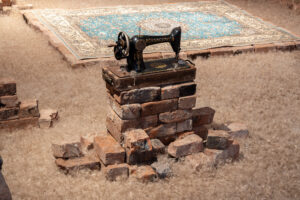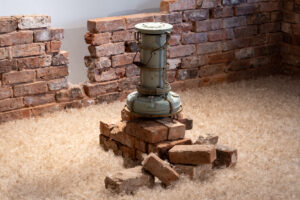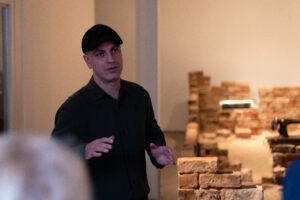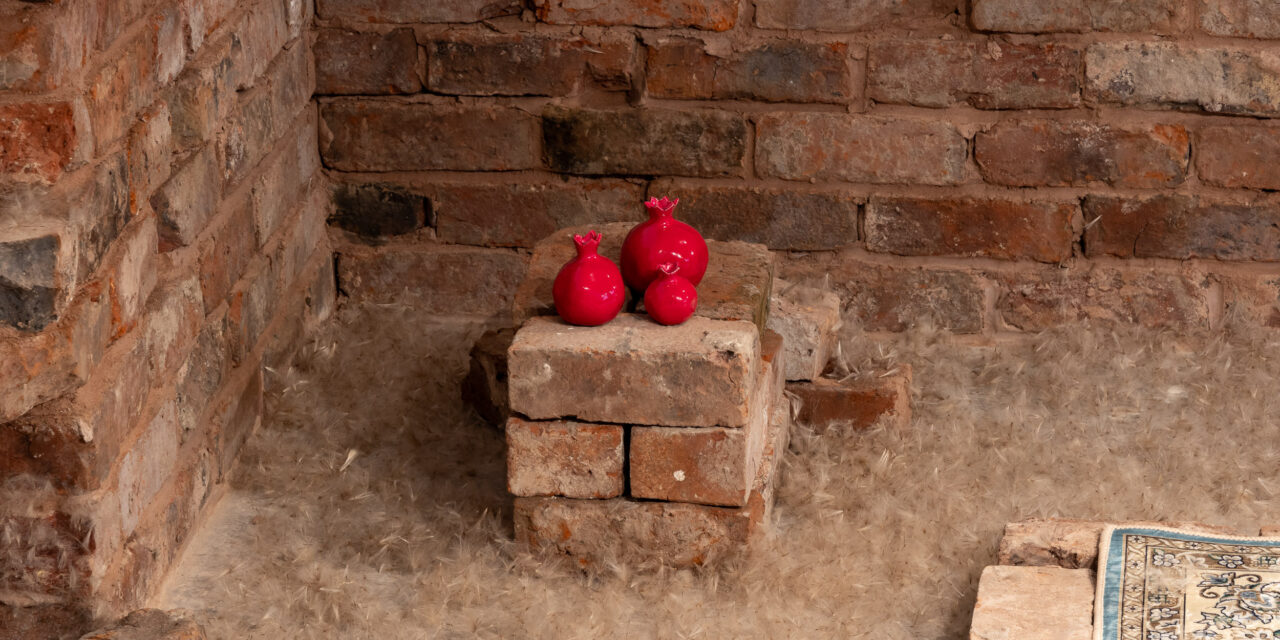“You know when, as a kid, you would build a home with cushions and it would make you feel good, it would be a space to play, to create? I built this to feel that way.”
These are the words of the artist Omid Asadi whom I spoke to at Manchester’s Castlefield Gallery where his first major UK solo exhibition is on display.
Born in Iran in 1979, Asadi moved to Britain in 2007 and embarked on a remarkable journey which culminated with an MA in Fine Art from Manchester School of Art in 2018. Today, he weaves personal history with artistic exploration. When I interviewed him, he told me about visiting his childhood home when he returned for the death of his mother. He discovered that it had been demolished to make way for a new development. The sense of loss he was already feeling became even stronger, and he associates the biggest piece in the exhibition, Resonance and Remnants, to that emotion.
Inside the main exhibition space, the visitor is faced with a room inside a room – half-demolished or half-finished. The foundations of red bricks are laid and define the rectangular perimeter of the house. At their highest point, the walls struggle to reach three feet. A single, almost free-standing door is placed in the middle of one of the short sides of the rectangle while pillars of bricks work as pedestals for everyday objects: a sewing machine, a telephone, a cassette player. The sound of the Persian language fills the space, and the smell of incense finishes off the immersive experience. The entire area inside the broken-down brick walls of this home is awash with dandelion seeds.

Omid Asadi, Resonance and Remnants (2023). Photo by Jules Lister.
When I ask Asadi about the visual contrast between the bricks and the dandelions, he confirms that it is a deliberate choice.
“I always love to bring things together when they shouldn’t be together. It feels good to bring together things that are different, but also complete each other in some way. When I put the dandelions in the piece, it became something else completely.
“When I was a child, I had lots of pigeons, but my parents didn’t like them, and they had to give the pigeons to someone else. I collected dandelions and put them inside the cages I had for the pigeons.”
So, you used the dandelions to represent the loss of the pigeons as a kid, and now, dandelions are filling this up?
“Yes. Another aspect for the dandelions is that, in my language, the word for dandelion means small messenger, so when we catch it, we say our wish, and we tell the dandelion to give it to the person we are thinking of, and then we let it fly away. I always hear bad news coming from my country, so I have been frustratingly looking for a good message; if the dandelion is the little messenger, I collected thousands of them, looking for that good message.”
While the initial inspiration for the installation is linked to the artist’s own life, the piece can be read in many ways, as Asadi explains.
“This installation comes from my personal experience, but it is related to many. Many people cry, and that’s because something is coming from a personal level, but it can be collective as well, and I have seen different people seeing different things in it. For one person, the piece was about colonial history, for another, it reminded her of her grandma. As an artist, it is better if you don’t dictate anything, and you leave the people to imagine and live the work.
“In the bricks, viewers can find a political reading. The city where I was born is the first refinery in the Middle East, and BP was born there. They brought bricks all the way from the United Kingdom to Iran to build the houses for their engineers and staff. So, this is related to the role of oil in my country, and to the war and problems it causes in the Middle East which are still continuing.

Omid Asadi, Resonance and Remnants (2023). Photo by Jules Lister.
“These bricks are from here, they are what’s left from demolished houses, and we worked with a company that redistributes them.”
So, someone could have the same experience you had, of not finding their house anymore because it has been demolished, and those bricks are being used in this piece to recreate that experience?
“Exactly, yes, that’s why it was more interesting to me to use these than to buy new bricks, because in my imagination every piece has a story inside. And, I could have made a painting about the experience of not finding my home anymore, but this project has brought lots of people together, from scientists, labourers, lots of volunteers, different people from different fields, and this is what I really liked about it.”
Asadi tells me how all of the objects have specific references to his childhood memories, and the cassettes play poems and stories that were always playing in his house.
“The sound, that would always be in my home, works like a perfume for me, it brings the home back. The phone brings some sadness. When I came here, the only way I had to connect to my father and my mother was a phone, and when they’ve gone, I felt like I should have at least rung more. I know how much they were waiting, sitting near that phone, waiting for my call.
I wonder if that, in creating this piece, it has made Asadi feel better and safer, like a child in an imaginary cushion house?
“Yes. It doesn’t resolve the struggles, but I feel less pressure. My home is not here anymore [points at the outside space], but it’s here [points at his heart].”

Omid Asadi in front of Resonance and Remnants (2023). Photo by Kate Hardy.
Main image: Omid Asadi, Resonance and Remnants (2023). Photo by Jules Lister.
Omid Asadi’s solo exhibition is at Castlefield Gallery, Manchester until January 21, 2024. For more information, click here.








